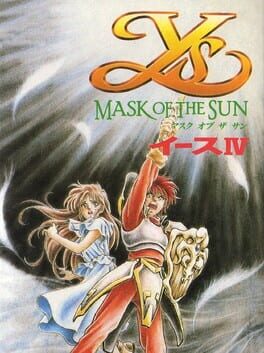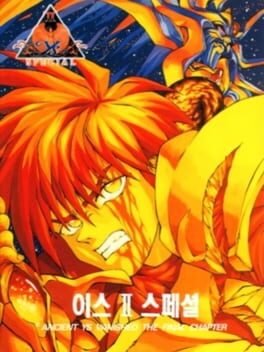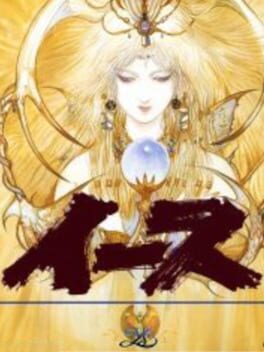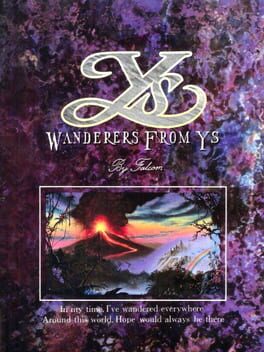

After having defeated the ultimate evil in his previous adventure, the great hero Adol stands on a sea shore, thinking about the fate of the once peaceful Utopian land of Ys, while the wind is blowing through his red hair. Suddenly, Adol notices a bottle, thrown onto the shore. It contains a letter, written in a foreign language, in which an unknown person asks Adol to come to his land and save it from a mysterious evil. Adol decides to accept the offer, and thus his adventure begins again... Ys IV: Mask of the Sun is an action RPG with a combat system like the earlier Ys games. An enemy should be rammed from the sides in order to hurt him. If performed incorrectly, the player will get hurt himself. It's also possible to use magic and position oneself strategically in battle so that the enemy won't be able to inflict any damage.
Also in series
Reviews View More
Mask of the Sun begins with Adol, our hero of Ys, finding a message in a bottle on the beach one day. The unfamiliar language inside, once translated for him by a friend, simply reads as a message to save a far-off land named “Celceta”. Adol quickly hops on a ship and sets off towards adventure in this land that apparently so badly needs saving. As was the case with Ys III, this is yet another good step forward in story writing for the series (despite effectively being written by completely different people). We have a more tightly paced story with better developed characters, and though I’d say we’re not quite at the level yet where we’re telling a story with deeper themes and messaging, we’re very nearly there! Granted, some of the messages you can read into Ys IV are less than positive in some respects, but they’re unintentional to the point that I don’t think they hurt the overall story too much ^^;. Oddly enough, even though this game has a ton of connective tissue to Ys I & II, it never mentions Ys III’s story at all. This isn’t really a problem, of course, but it was something that made me giggle nonetheless, especially with just how much this story so easily reads like an actual narrative sequel to Ys II, far more than Ys III ever did XD.
This goes beyond narrative as well, for Ys IV actually has a ton of connective tissue to I & II in its mechanics as well: Bump combat is back! I’ll admit, I was pretty bummed to see the return of bump combat, as I didn’t particularly enjoy it in Ys I & II, but I actually enjoyed it here a fair bit more than I did in those games. I understand that the overall premise (hitting enemies not dead-on deals damage where dealing direct bumps tends to just get yourself hurt) is basically the exact same way that bump combat works in I & II as well, but I noticed it far FAR more here than I ever did in those games. It’s an element of this game’s combat that’s far more unignorable than it ever was in those games due to how this game is balanced, and it makes for a much more challenging and interesting version of bump combat as a result. I found myself actually enjoying normal combat far more than I ever had in I & II, and it made combat feel a lot less overall pointless as a result.
Honestly, the mechanics overall are much stronger than I & II’s were, which I was very happy to see. Though there’s still some rough signposting here and there, it was never anything nearly so bad as plagued the far earlier adventure game designs of I & II. Though there were some things I had to look up in a guide at some points, they were almost always things that had just totally slipped my mind rather than things that I’d had no way of knowing the way those earlier games struggle with signposting. Level design on the whole was something I found markedly improved from the first two bump combat games, and the same goes for boss design as well.
These bosses felt far more actually designed than the first two games’ bosses usually did, and there was always some meaningful element of figuring out the strategy I needed rather than the old bump combat strategy I’d gotten used to where I just charged forward, hoped for the best, and usually won almost instantly. Magic is also back, and it depends on the sword you’re using instead of having bespoke spells you’re choosing from. I never found it super useful, as bump combat on its own was generally more than enough, but it was nice to have the option at least. I’m not sure this is going to convert anyone who already hated bump combat, and this game is certainly just as grindy as those old games were for having the right levels to take on the challenges you’re facing, but it was at least nice to see Ys return to that old formula and improve on it so significantly (despite the dev team being completely different x3).
The presentation is a bit simple for a mid-/late-life SFC game, but I still liked it quite a bit. Enemy, especially boss sprites, are well designed and cool looking, and the cutscene animations are very fun despite the relatively simple character and environment sprites. There’s a charm to things much like RPG Maker games would later have, with characters spinning on the spot or running around to indicate emotions in a way that I found very delightful, and some bespoke animations for certain cutscenes that had me giggling like a madman in my seat (like when Adol gets struck by lightning XD). The music is also unsurprisingly excellent. There were a lot of times where it almost felt like I’d stepped into a Mega Man X soundtrack all of a sudden, and I absolutely mean that as a compliment. An Ys game through and through, this game is packed with good and rockin’ tracks to fight monsters and witness drama, and that’s about all you could hope for, even in an Ys game not developed by Falcom themselves.
Verdict: Recommended. This is one that is very borderline between a hesitant and a normal recommendation, but I think it’s overall solid enough that I’d recommend it about as much as I would other less-than-perfect 16-bit action/adventure games I’ve played recently. Combat is quick and fun, boss battles are great, music is awesome, and the signposting is usually right on point. It’s honestly very confusing to me that this game has such a negative reputation. While I’d certainly believe the PCE version of Ys IV may indeed be better, I’d have a very hard time listing basically any way that the PCE version of Ys I & II is better than this game outside of that game’s CD-quality audio. This may not be the best of the Ys series, but I think that’s something you can really safely say about any of the Ys games made before Ys Origins. This game is good fun! Even if, as I said before, this probably won’t convert anyone who was already a non-believer in bump combat, I can still say with a good degree of confidence that, if you liked Ys I & II, I think you’ll probably really like this game too~.
I didn't fight the final boss at max level just because it would have taken forever
That being said though, I did feel like I understood where everything was in relation to each other, not as linear as Dawn. The bosses were extremely easy as long as I avoided their attacks (except Gruda what were they thinking that guy was almost as bad as SNES Galbalan)





